


Studying charts and scanning technical indicators help traders identify a cryptocurrency's price patterns, but they only offer a surface-level analysis. Crypto traders looking to decode the deepest depths of their favorite digital assets often turn away from trading volumes and toward the latest transaction trends.
Every transfer on public blockchains posts on transparent and tamper-proof payment ledgers, allowing anyone with internet access to be able peer into these priceless crypto records. The findings from a thorough onchain analysis open more possibilities for crypto traders and reveal unique—and potentially profitable—details about a blockchain's ecosystem.
In this guide, we’ll review the basics of onchain analysis and how traders use it to make sense of the crypto market’s movements. The more traders know about the pros and cons of onchain analysis, the easier it is to make decisions when swapping digital assets.
What is onchain crypto analysis?
Onchain analysis is a branch of market research specific to crypto focusing on posted, public transactions. Public blockchains like Bitcoin (BTC) and Ethereum (ETH) have open-source records of every transfer on their respective blockchains, making it possible for traders and financial analysts to analyze the inner workings of different decentralized networks.
People using onchain analysis look into the number of active crypto wallets, suspiciously large transfers, or token distribution percentages to accurately gauge current network activity. Traders then use these onchain findings to inform their opinions on a cryptocurrency's future potential and build a trading thesis.
How does crypto onchain analysis work?
Onchain analysis relies on the inherent transparency of blockchain technology and the accessibility of decentralized payment ledgers. Every crypto transfer and active wallet address leaves an imprint on a blockchain's permanent, publicly viewable payment ledger, which contains details stretching back to the first crypto transaction on the chain (aka the genesis block). Because blockchains establish trust using transparent digital records rather than external third parties, all details of these crypto movements are available for review online.
Onchain analytics platforms offer traders advanced information into multiple influential data points, including average transaction volumes, wallet activity, and network fees.
For example, blockchain explorers like Etherscan and Blockchain.com allow users to search through historical and real-time information on crypto transactions for blockchains like Ethereum and Bitcoin. A few third-party onchain analytics firms like Glassnode, Nansen, or Messari also use proprietary tools to filter through these public payment databases and present their findings to clients.
Onchain versus offchain analysis: Key differences
Onchain analysis solely focuses on transaction data tied to a blockchain, whereas offchain analysis looks into external metrics influencing a cryptocurrency's price.
For example, if traders want to gauge the market sentiment for a cryptocurrency using offchain analytics, they could look into social media trends, major news events, and trading volumes on exchanges. Offchain analysis also includes technical indicators used to interpret price charts, including tools like moving average trendlines, chart patterns, and the moving average convergence divergence (MACD).
While offchain factors don't give direct insight into a blockchain’s activity, they highlight major metrics influencing a price performance.
Common crypto onchain analysis strategies
Many blockchain-specific metrics exist, and each trader focuses on specific areas of onchain analysis per their strategies. However, crypto traders use a few foundational onchain analytics tools when researching. Here are a few:
Average transaction volumes
A straightforward way to assess demand for a cryptocurrency is to review the average onchain transaction volumes over a set timeframe. Comparing currently posted volumes to average rates in the past months or years gives long-term crypto traders (aka HODLers) a clearer sense of a cryptocurrency's growth. Alternatively, for day or swing traders, studying transaction volumes on shorter time frames helps spot unexpectedly volatile movements and potentially identify momentum-based trading opportunities.
If average daily transactions continue to climb despite how a cryptocurrency's market price moves, it suggests rising demand for a blockchain's services and sustained upward (or bullish) momentum. In contrast, declining or stagnant transaction values are often interpreted as unfavorable (or bearish) for a cryptocurrency's price potential.
Wallet addresses
In addition to rising transaction values, bullish traders like to see their favorite blockchains have a growing list of users. One way to understand how many people store and swap a cryptocurrency is to count and compare the number of new and active wallet addresses.
If the number of unique wallets continues to rise, it may suggest increased interest in a cryptocurrency, growing decentralization, and heightened network participation. However, if blockchains continuously struggle to attract more people to set up wallets and use their services, traders often question a crypto ecosystem's sustainability.
Token distribution
It's not enough for bullish traders if more wallets transfer more crypto on a blockchain. While both onchain signals are positive news, traders also care how evenly distributed virtual currencies are on their network.
If onchain analysis reveals a small percentage of wallets hold the lion's share of a cryptocurrency, people often express concerns over network centralization—especially if a blockchain's token gives holders voting rights on decentralized governance proposals.
Ideally, tokens are evenly spread on a blockchain to promote network decentralization, avoid governance or price manipulation, and increase the odds of a project’s long-term stability.
Mining or staking activity
While rising transactions and wallets are positive signs, traders must ensure their blockchain's backbone is sturdy enough to handle this increasing network load. One way to screen the health of a cryptocurrency's infrastructure is to look at how many computers (aka nodes) contribute to the network's security.
Because blockchains are decentralized, they rely on external participants to download payment ledgers, join the network, and contribute to the validation process using a consensus algorithm.
On blockchains using a proof-of-work (PoW) algorithm like Bitcoin, nodes (aka miners) use hardware units like ASIC rigs to solve advanced equations for the chance of posting a new transaction block and receiving BTC rewards. The PoW mining system is energy-intensive, so traders often look into the overall hash rate to determine the blockchain's full power. Analysts also consider the geographic distribution of notes on a PoW blockchain to check for network decentralization.
In contrast, blockchains using the proof-of-stake (PoS) algorithm make nodes lock (aka stake) the native cryptocurrency onchain to participate in transaction validation. To check the security and decentralization of PoS chains, onchain analytics firms focus on the number of validator nodes, the amount of cryptocurrency currently staked, and how concentrated these staked coins are in a few wallet addresses.
Whale or institutional movements
It's ideal for blockchains to have an equitable token distribution, but traders with massive crypto holdings (aka whales) exist on most blockchains. Whether these whales were early adopters of a cryptocurrency or major financial institutions, they have significant power to sway a crypto asset's supply and demand dynamics—so many traders watch out for their moves.
Some onchain analysis companies like Whale Alert focus on reporting large crypto transfers between wallets or exchanges, giving traders a glimpse into how cryptocurrency's largest HODLers prepare their portfolios. Monitoring these whale movements is particularly helpful when analyzing volatile intraday price movements, interpreting technical patterns, and spotting potential market manipulation techniques like the Wyckoff method.
Pros and cons of using blockchain analysis
Onchain analysis seems like the ultimate cheat code in cryptocurrency trading, but there are downsides to over-reliance on these metrics. Although onchain analysis provides many helpful clues into a cryptocurrency's ecosystem, traders often use these findings alongside fundamental and technical indicators for a more balanced view of their target blockchain.
Pros
Transparent and objective
The immutability and decentralization of distributed payment ledgers give onchain analysis its unique value proposition. This enhanced transparency reduces the risk of tampered information and data manipulation, providing traders with a clean, reliable, and objective dataset to build their trading thesis.
Easy to access and interpret
Onchain analysis is objectively verifiable and readily available to anyone with an internet connection. Whether traders use blockchain explorers or data from third-party onchain firms, many platforms offer their analytics to a global audience and provide users with clean graphs, charts, and interfaces to make interpreting this data a breeze.
Provides historical information
For HODLers, onchain analysis showcases the historical record for a cryptocurrency going back to the genesis block. This long track record helps traders evaluate a cryptocurrency's multiyear growth, identify price patterns, and determine historical trends to better predict the future potential for a crypto project.
Real-time monitoring
Onchain analysis is helpful for long-term trends, but it's also useful for short-duration traders interested in what's happening right now. Whether identifying unexpected volume spikes or monitoring whale movements, onchain analytics provide valuable real-time info to help traders make quick decisions in the volatile cryptocurrency market.
Useful for comparative analysis
Crypto traders also turn to onchain analytics when comparing the strengths and weaknesses of cryptocurrencies in a similar category.
For example, traders interested in GameFi cryptocurrency projects look through metrics like average transaction volumes, active wallet addresses, and token distributions on Web3 gaming projects to see which applications have the most attractive features.
Cons
Doesn't explain price movements
The narrow focus on blockchain transactions gives traders a sense of what's happening onchain, but it can't answer the why behind this data. Traders need the extra context from fundamental research (e.g., news, software upgrades, or market sentiment) to understand the possible reasons behind a cryptocurrency's transaction flows.
Potential counterparty risks
If traders depend on third-party research firms like Nansen for onchain analytics, they have to trust the accuracy and expertise of the research team. Even if onchain analysis firms have a solid reputation, they introduce a potential for counterparty risks, including data inaccuracies, biases, or conflicts of interest.
Sometimes includes market noise
Onchain analysis tools are sensitive to the sporadic spikes in the volatile crypto market, which often adds unnecessary data points (aka market noise) to the latest findings. Even experienced crypto traders have difficulty separating these irrelevant, short-lived movements from meaningful trends, especially on short timeframes.
Open secret
Two major benefits of onchain analysis are its transparency and accessibility, but these features also make onchain data open knowledge in the crypto community. Crypto traders don't have an edge in placing their positions with onchain data because these charts are so widely available.
Put onchain analysis into action with dYdX perps
Whether eligible traders prefer focusing on technical, fundamental, or onchain analysis, dYdX can set precise perpetuals trading strategies. On the Cosmos-based dYdX Chain, eligible traders enjoy deep liquidity for Bitcoin and altcoin perps, including advanced features like customizable order types, leverage, and slippage tolerance controls.
For more details on how trading on dYdX Chain works, check out dYdX's official blog for the latest updates. Also, head to dYdX Academy for dozens of other guides on trading strategies, blockchain tech, and opportunities in Web3.
Eligible traders can Start trading on dYdX today.
Disclosures
The content of this article (the “Article”) is provided for general informational purposes only. Reference to any specific strategy, technique, product, service, or entity does not constitute an endorsement or recommendation by dYdX Trading Inc., or any affiliate, agent, or representative thereof (“dYdX”). Use of strategies, techniques, products or services referenced in this Article may involve material risks, including the risk of financial losses arising from the volatility, operational loss, or nonconsensual liquidation of digital assets. The content of this Article does not constitute, and should not be considered, construed, or relied upon as, financial advice, legal advice, tax advice, investment advice, or advice of any other nature; and the content of this Article is not an offer, solicitation or call to action to make any investment, or purchase any crypto asset, of any kind. dYdX makes no representation, assurance or guarantee as to the accuracy, completeness, timeliness, suitability, or validity of any information in this Article or any third-party website that may be linked to it. You are solely responsible for conducting independent research, performing due diligence, and/or seeking advice from a professional advisor prior to taking any financial, tax, legal, or investment action.
You may only use the dYdX Services in compliance with the dYdX Terms of Use available here, including the geographic restrictions therein.
Any applicable sponsorship in connection with this Article will be disclosed, and any reference to a sponsor in this Article is for disclosure purposes, or informational in nature, and in any event is not a call to action to make an investment, acquire a service or product, or purchase crypto assets. This Article does not offer the purchase or sale of any financial instruments or related services.
By accessing this Article and taking any action in connection with the information contained in this Article, you agree that dYdX is not responsible, directly or indirectly, for any errors, omissions, or delays related to this Article, or any damage, injury, or loss incurred in connection with use of or reliance on the content of this Article, including any specific strategy, technique, product, service, or entity that may be referenced in the Article.







